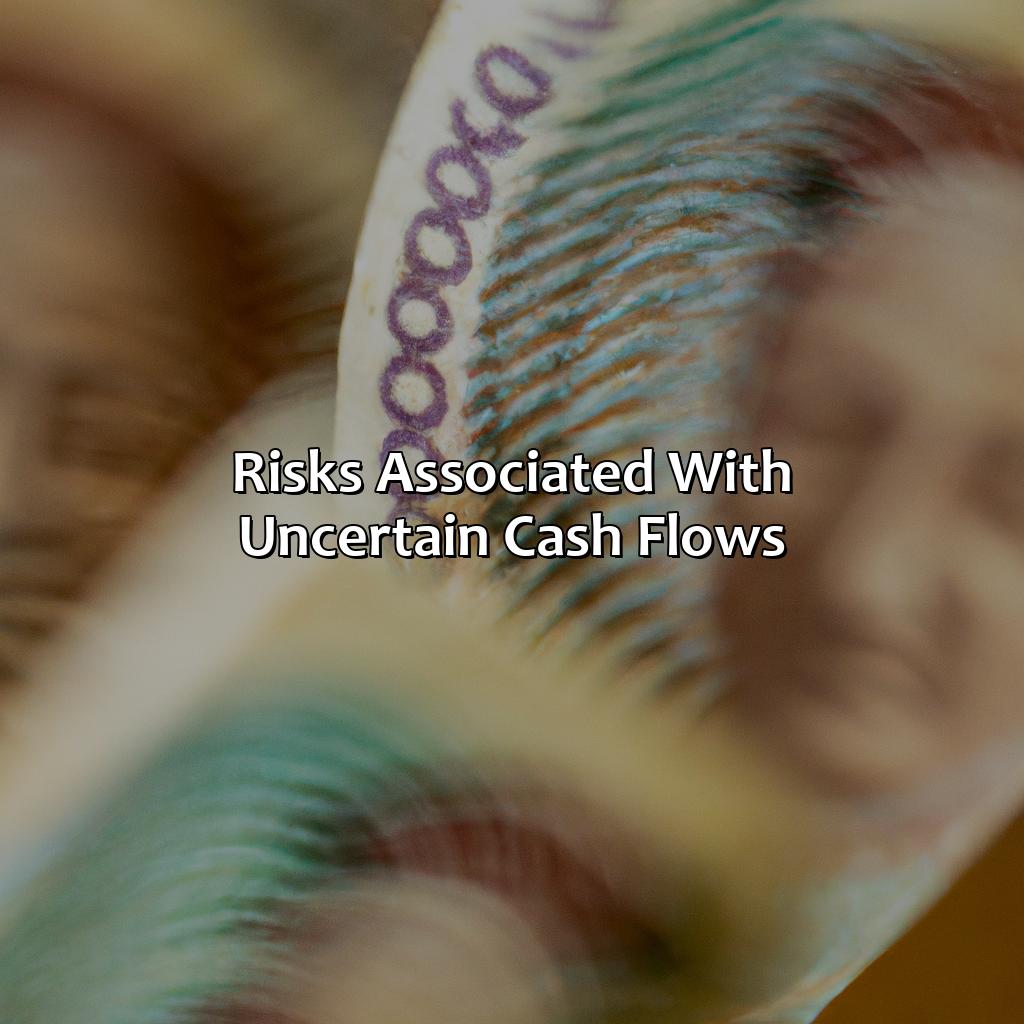When Analyzing An Investment Project, Uncertain Future Cash Flows?
Key takeaways:
- Uncertain future cash flows can pose a threat to investment projects, necessitating the use of techniques that aid in assessing the likelihood of such outcomes.
- There are several factors that may contribute to uncertain cash flows, including economic policies, changes in technology, and market competition.
- The three primary techniques used to evaluate uncertain cash flows are sensitivity analysis, scenario analysis, and Monte Carlo simulation, each with their own advantages and disadvantages.
- Given the risks associated with investing in projects with uncertain cash flows, it is essential to identify and manage these risks, including business and financial risk, to increase the chances of a successful outcome.
Are you feeling overwhelmed by the uncertain future cash flows when analyzing an investment project? Don’t fret, this article provides you with practical solutions to make the decision-making process easier. Read on to learn more about how to approach cash flow analysis in an uncertain economic climate.
Importance of cash flow analysis in investment projects
Cash flow analysis plays a critical role in determining investment project viability. It involves evaluating the incoming and outgoing cash flow to determine present and future project value. Accurately demonstrating future cash flow estimates aids investors in the decision-making process. By analyzing potential financial risks and opportunities during the project life cycle, investors can make informed investment decisions. Investing without cash flow considerations may have detrimental impacts on the investment outcome.
Incorporating cash flow projections provides a more comprehensive understanding of an investment’s profitability and potential risks. Evaluating cash flow enables investors to identify the areas of an investment that may require more attention and resources. Additionally, it mitigates the risk of relying solely on profits and provides a long-term perspective. Investors who fail to consider cash flow inevitably risk loss of capital or lower return on investment.
Effective cash flow analysis techniques contribute to predicting the investment outcome with greater accuracy and confidence. By performing in-depth research and incorporating investment data, investors can estimate future cash flow projections. This provides valuable insights into expected project outcomes and informs strategic investment decisions.
A true fact is “According to a study by SageWorks, businesses that have accurate cash flow projections are 80% more likely to survive and succeed.”

Image credits: retiregenz.com by James Woodhock
Factors that affect uncertain cash flows
Investment projects can be affected by uncertain cash flows. To understand this, focus on market competition, economic conditions and technological changes. These sub-sections are vital for gauging a project’s future cash flow viability.

Image credits: retiregenz.com by Adam Washington
Market competition
The presence of other industry players can significantly impact the cash flows of an investment project. Overly competitive market environments can lead to lower profits due to lower pricing power and higher expenses for advertising and marketing activities. Therefore, market saturation should be considered when analyzing potential returns on investment projects.
Industries with a high level of competition may require unique value propositions or other significant differentiators to succeed. Businesses should consider factors such as brand recognition, location, product quality, price sensitivity and customer satisfaction while analyzing their competition.
It is essential to note that complete market domination is rare in most industries, making it possible for new entrants or startups to enter the marketplace. It is important to consider not only current competitors but also potential ones on the horizon.
According to a study by Harvard Business Review, businesses can benefit from strategic collaboration and partnership with their competitors rather than solely focusing on rivalry.
Trying to predict the economy is like trying to predict the weather – it’s mostly cloudy with a chance of inaccurate forecasts.
Economic conditions
Investment projects are subject to the whims of the market, making uncertain cash flows a common threat. The economic stability of a region is a crucial factor that affects these fluctuations and influences investment decisions. The viability of an investment project depends on the economic conditions that surround it, including inflation rates, interest rates, tax policies, exchange rates, and market trends.
Understanding economic conditions is vital because it provides investors with insight into the current state of the economy and the likelihood of future changes that could have an impact on their investments. Inflation rates can affect purchasing power while interest rates will have an impact on financing costs. Tax policies will also determine how much revenue is retained by businesses versus being paid out to the government.
Furthermore, exchange rates and market trends directly influence international business operations; thus predictability is crucial for proper planning. Apart from understanding regional economic stability, analyzing your company’s financial circumstances such as free cash flow may help you determine if you can handle investment risks.
When we look back to the 2008 financial crisis sparked by subprime mortgage lending collapse, it changed industries worldwide. It served as a reminder that even well-performing markets can suddenly decline in value without warning causing significant consequences. To this day, many companies are recovering from that devasting loss.
Technological changes can make or break a cash flow forecast, just ask Blockbuster Video and the makers of the Nokia 3310.
Technological changes
The impact of emerging technological advancements is undeniable when it comes to evaluating future cash flows in investment projects. With rapid changes in technology, forecasting future returns can become a daunting task for analysts and investors alike.
New software, hardware, or digital tools that can streamline production processes or revolutionize an entire industry often lead to unpredictable outcomes. Quicker product cycles and competition may result in sudden depreciation of assets and consequent plunges in profits or sales figures.
Furthermore, these technological changes affect not only the direct use of information technology but also various backward-forward linkages with suppliers, customers, and the larger community. For example, any delay in the delivery schedule of goods by suppliers due to IT failures affects a firm’s output schedule, leading to cost overruns.
In recent years, companies such as Blockbuster Video and Kodak have failed to adapt to changing consumer behavior arising from technological advancements adequately. These companies failed to foresee the rapid shift towards streaming services and digital photography respectively leading them lagging behind their competitors ultimately resulting in bankruptcy.
It is essential for investors to examine historical trends of technological changes within an industry; this will help analyze how quickly new advancements are adopted. Evaluating various macroeconomic indicators such as interest rates, inflation rates, government regulations among others also aid in gauging investor risk tolerance before investing in uncertain future cash flows brought about by tech disruptions.
Evaluating uncertain cash flows is like playing poker – you need to know when to hold ’em, when to fold ’em, and when to calculate the expected value.
Techniques for evaluating uncertain cash flows
Evaluating uncertain cash-flows for an investment project? Sensitivity analysis tests stability by changing certain variables. Scenario analysis forecasts potential outcomes of different events. Monte Carlo simulation models out different outcomes based on probability of scenarios occurring.

Image credits: retiregenz.com by Adam Washington
Sensitivity analysis
When evaluating investment projects with uncertain future cash flows, analyzing the impact of changes in underlying assumptions is crucial. This process is commonly referred to as Variance Analysis and allows for a deeper understanding of the range of possible outcomes.
In this table demonstrating Sensitivity Analysis, we have created three different scenarios by changing the assumption values associated with initial revenue, operating costs, and discount rates. This process has allowed us to create estimated ranges of possible financial outcomes based on variations in initial investment and earnings.
| Assumption | Base Case | Scenario 1 | Scenario 2 |
|---|---|---|---|
| Initial Revenue | 100,000 | 80,000 | 120,000 |
| Operating Costs | 50,000 | 65,000 | 45,000 |
| Discount Rate | 8% | 9% | 7% |
It’s important to note that Sensitivity Analysis is an iterative process that requires constant comparison between assumptions and real-time data. By routinely conducting Variance Analyses throughout a project’s lifecycle, teams can identify emerging trends or shifts in underlying variables.
Throughout the evolution of modern finance theory and practical application across various industries from oil & gas exploration to healthcare investments, the utilization of Sensitivity Analyses has become commonplace. Teams continue to seek out ways to refine their approaches to achieve more accurate projections when evaluating investments.
Why have a crystal ball when you can just do scenario analysis and pretend you have one?
Scenario analysis
When analyzing uncertain cash flows, an investment project can benefit from a technique called Sensitivity Analysis. It involves examining the effect of different variables on the project’s net present value and identifying those that have the most significant impact. By changing one variable at a time and observing how the NPV is affected, decision-makers can gain insights into the best-case scenario, worst-case scenario, and expected value.
Another useful technique for evaluating uncertain cash flows is Probability Analysis. In this method, we assign probabilities to different outcomes based on historical data or expert opinions. The potential cash flows are then discounted at a rate that reflects their level of risk to give us a range of possible NPVs. This approach can be useful when dealing with more complex projects that involve multiple uncertainties.
It is essential to note that while Scenario Analysis and Monte Carlo Simulation are often used interchangeably as evaluation techniques, they are not the same thing. Monte Carlo simulation involves generating multiple scenarios by randomly selecting values from predefined probability distributions and running simulations to determine the NPV distribution. In comparison, Scenario analysis involves creating scenarios by explicitly specifying sets of values and determining their associated NPVs.
Pro Tip: When selecting between these techniques, it is important to consider which best suits your needs based on factors such as simplicity versus complexity, accuracy versus speed, level of uncertainty involved in the project’s environment, and availability of data and resources. If you thought Monte Carlo simulation was just a gambling game, think again- it’s actually a useful tool for evaluating uncertain cash flows in investments.
Monte Carlo simulation
When evaluating the uncertain cash flows of an investment project, various techniques can be used to reduce risk and increase certainty. One such technique is the application of a probabilistic modeling approach known as the Monte Carlo simulation. This simulation involves analyzing thousands or millions of simulated scenarios based on random variables that represent different factors affecting cash flows, such as exchange rates or market trends.
By using Monte Carlo simulation, investors can better understand their potential outcomes in different scenarios and evaluate the expected value and variability of cash flow outcomes. Through this process, they can gain insight into key risk drivers and make more informed decisions. The technique provides analytical support for diverse applications in finance, economics, and supply chain management.
Apart from Monte Carlo simulation, several other methods are often applied when assessing uncertain cash flows. These include sensitivity analysis, scenario analysis, decision trees, real options analysis, etc. Each technique is unique in its way but serves to provide more clarity around possible scenarios or influences impacting future cash flows.
Frank Knight was one of the first economists to identify uncertainty as something distinct from risk. His work explores how entrepreneurs and investors navigate uncertain circumstances when faced with significant unknowns that cannot be precisely measured or quantified. Consequently, over time these theories developed to assist companies adopt intelligent hedging strategies regarding investments with risky financial implications such as stock-market investing or commodities trading.
Uncertain cash flows are like a blind date – you never know what you’re going to get, but the risks are high either way.
Risks associated with uncertain cash flows
To maximize returns when analyzing an investment project, one must understand the risks of uncertain cash flows. These risks are classified as business and financial. Each has its own particular difficulties and outcomes.

Image credits: retiregenz.com by David Arnold
Business risk
In assessing investment viability, potential risks to profitability should be considered. Operational uncertainty and unpredictability in monetary inflows and outflows constitute a prime risk of business failure. Risk management experts define this as Revenue Risk.
One way to manage revenue risk is to ensure diversification of revenue streams to avoid being overly dependent on one source of income. Another suggestion is setting up contractual agreements with counterparties so as to stabilize cash flows, thereby reducing uncertainties.
Additionally, companies experiencing fluctuating cash flow cycles may offset revenue risks by conducting sensitivity analyses and strategic contingency planning. In particular, scenarios that involve projections for worst-case events help build resilience against unforeseen upheavals.
These proactive steps will reduce the impact of revenue uncertainties on the bottom line while positioning businesses for success in the marketplace.
Financial risk is like a game of Jenga – you never know which piece will bring your investment crashing down.
Financial risk
Investment risk – Uncertainty in future cash flows can increase the risk of an investment. It is essential to evaluate an investment’s cash flows in a range of scenarios with various outcomes and probabilities to determine the level of potential risk. Investment decisions are critical, and investors must weigh the risk against potential returns.
Uncertain future cash flows create a significant challenge for investors in determining the level of risk associated with their investments. Financial analysts use various techniques such as sensitivity analysis, scenario analysis, and simulation methods to assess project risks. Based on these analyses or forecasts, they ensure that things are balanced regarding risks and returns when investing.
When evaluating financial risks associated with uncertain future cash flows, it’s essential to consider the time value of money, final investment costs, inflation rates, impact on debt financing availability, and other contingencies affecting potential returns.
For instance, financial experts advised an MNC against building a new manufacturing plant as they had forecasted substantial financial risks due to increased competition from emerging markets coupled with elevated raw material prices. The company took note and opted either not to proceed or take measures to mitigate the projected risks.
Five Facts About Analyzing Investment Project with Uncertain Future Cash Flows:
- ✅ Future cash flows are uncertain, making it difficult to accurately analyze an investment project. (Source: Investopedia)
- ✅ Discounted cash flow (DCF) analysis is a commonly used method for evaluating uncertain cash flows. (Source: CFI)
- ✅ Sensitivity analysis is critical to assess the impact of changes in cash flows on investment decisions. (Source: Harvard Business Review)
- ✅ Monte Carlo simulation is another tool that can be used to account for uncertain cash flows. (Source: Corporate Finance Institute)
- ✅ Proper risk management and risk-adjusted discount rates are essential for analyzing investment projects with uncertain cash flows. (Source: Wall Street Prep)
FAQs about When Analyzing An Investment Project, Uncertain Future Cash Flows?
What is uncertain future cash flow in an investment project?
Uncertain future cash flows are financial outcomes that cannot be predicted with certainty in an investment project. They depend on various factors such as market conditions, government regulations, and competition.
How do you analyze an investment project with uncertain future cash flows?
When analyzing an investment project with uncertain future cash flows, you should use methods such as sensitivity analysis, scenario analysis, and Monte Carlo simulation. These methods help you understand the range of possible outcomes and the probability of each outcome occurring.
What is sensitivity analysis in investment project analysis?
Sensitivity analysis is a method used to determine how changes in one variable affect the outcome of an investment project. It helps you understand which variables have the most significant impact on the project’s profitability.
What is scenario analysis in investment project analysis?
Scenario analysis is a method used to analyze the impact of different scenarios on an investment project’s profitability. It involves creating different scenarios based on different assumptions and evaluating the impact each scenario has on the project’s cash flows.
What is Monte Carlo simulation in investment project analysis?
Monte Carlo simulation is a method used to create thousands of random simulations of an investment project’s possible outcomes. It is based on statistical analysis and helps you understand the probability of different outcomes occurring.
How do you mitigate the risk of uncertain future cash flows in an investment project?
You can mitigate the risk of uncertain future cash flows in an investment project by diversifying your investments, incorporating risk mitigation strategies such as hedging, and creating a contingency plan for unexpected events. It is important to have a solid understanding of the project’s risks and develop a risk management plan to minimize any negative impact on the project’s profitability.


